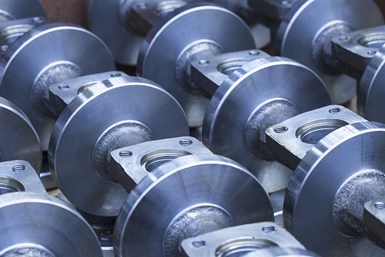CNC Machine Shops: Help Production Machining Help You
While our magazine’s editors keep up with CNC machining industry trends and technology, we remain open to hearing about article topics that you feel will help your business grow and become more efficient. Your feedback is welcome.

This is the month in which we tend to be more mindful of what makes us thankful. Professionally, as a member of this magazine’s team, I’m thankful to have readers like you and advertisers that support our brand, enabling us to deliver this magazine to you at no charge.
As a manufacturing writer for more than two decades, I’ve followed and interacted with the machining industry for a good long time. So, I think I know what we should be covering in Production Machining. But, feedback from you would be helpful to help ensure we present the type of information and fresh ideas that will enable you to boost your shop’s capabilities, become more efficient operations and grow your businesses.
What follows is a small sampling of topics, technology and trends beyond the universal skilled labor shortage which I believe to be on the minds of owners and managers of production machine shops like you. In effect, these represent subject matter that perhaps we should cover more in our magazine. What I’d ask of you is to let me know if there are other topics we should be covering on a more regular basis.
- Automation is more than robots. This is one trend highlighted in the September article “Precision Machining Technology Moving Shops Forward.” Certainly, robots are shedding the bad reputation of the past as they are now more flexible, easier to program and, in some cases, re-deployable to various machines. (Note our November cover story.) However, shops are also looking more at equipment such as tool presetters, on-machine part and tool probing, and in-process gaging to eliminate manual tasks (and the risk of error) from the machining process.
- High-production machines are becoming more flexible. While part volume requirements for production shops remain high, flexibility to pivot to different jobs is becoming more important. (An example of this was the need for shops to supply much-needed ventilator parts in the fight against COVID-19 even though they hadn’t previously produced them.) Builders of Swiss-types, multi-spindles and rotary transfer machines recognize and are modifying machine designs accordingly to be more versatile.
- Focus is shifting from hardware to software. Basic physics means machine tools have effectively hit the ceiling in terms of how fast they can remove material, their spindles can rotate, their axes can move and so on. This has shops looking more to software to boost overall process efficiencies. More capable and intuitive enterprise resource planning (ERP) software is becoming a big part of this. But, so is the ability to more easily pull data from machines, benefit from sensor technology to enable more adaptive machining and perform statistical process analysis. More shops will be hiring IT personnel to handle data analysis and equipment interconnectivity moving forward. Effective process control for high-volume operations is imperative.
- More efficient inspection processes are needed. Lights-out machining enables shops to get the most value out of their equipment and employees. What’s better than coming to your shop in the morning to find a number of parts machined unattended? However, that often means there are many parts in the queue to be inspected. Part measurement can become an early morning bottleneck that soaks up shopfloor workers’ valuable time. This has shops looking to new measurement technology that can speed and simplify part measurement (vision systems, for example) so workers can get back to other duties.
- More processes are being brought in house. In some respects, “machine shop” is no longer a valid description of a manufacturer with machining capability. Modern production manufacturers are looking to be one-stop shops for their customers. That has them eyeing processes and equipment that can enable them to machine, finish, assemble, package and perhaps even manage inventory for customers.
- Design for manufacturability advice is a value-add. High-volume contract shops tend to have tighter relationships with their customers than job shops. More importantly, they have a tighter relationship with their customers’ engineers, including some who don’t have machining knowledge or in-house machining expertise they can tap for design advice. Instead, these engineers increasingly rely on production machine shops to offer advice for ways to modify new product/part designs to speed and simplify machining. Shops providing this advice early in the new product design/prototyping process often end up winning the production work that will follow.
- Material issues remain issues. Access to the Precision Machined Products Association’s ListServes has been beneficial to help recognize what members’ pain points are and what challenges they face. One common topic members ask about is materials and their machinability. Perhaps this is something our magazine should address more.
So, what am I missing here? What other subject matter should we focus on? Shoot me an email. Thanks.
Read Next
Do You Have Single Points of Failure?
Plans need to be in place before a catastrophic event occurs.
Read More5 Aspects of PMTS I Appreciate
The three-day edition of the 2025 Precision Machining Technology Show kicks off at the start of April. I’ll be there, and here are some reasons why.
Read MoreA Tooling Workshop Worth a Visit
Marubeni Citizen-Cincom’s tooling and accessory workshop offers a chance to learn more about ancillary devices that can boost machining efficiency and capability.
Read More










.jpg;maxWidth=300;quality=90)





